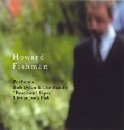
Howard Fishman
The Basement Tapes: Live at Joe's Pub
(Monkey Farm)
First Appeared in The Music Box, April 2007, Volume 14, #4
Written by John Metzger
![]()
In mid-1967, after crashing his motorcycle, Bob Dylan was forced to lay low for awhile in order to recover from his injuries. In the process, he discovered a new method for approaching his music. As far as the public was concerned, the jump that Dylan made between Blonde on Blondeís surreal landscapes and John Wesley Hardingís stark, country-blues refrains was unfathomable. The key to understanding it, however, lay within the material that he wrote and performed with The Band in the cellar of a home in Saugerties, New York that became known simply as "Big Pink." Despite the reclusiveness of the proceedings, the songs rapidly seeped into the fabric of Americaís popular culture. They were covered by The Byrds and Manfred Mann, and they provided the impetus for The Bandís debut Music from Big Pink. As for the recordings themselves, although they never were meant for release, they bolstered the legendary status of the informal sessions by turning up, first, as a bootleg and then ó eight years after the fact, in a skewed historical context ó as an official release that was dubbed The Basement Tapes.
Nearly 40 years after Dylanís transformation, Howard Fishman, himself one of New York Cityís more eccentrically eclectic folk artists, has seen fit to revisit the storied material. It all began with a series of concerts that were held in May 2006, and itís from these shows that Fishmanís latest outing The Basement Tapes: Live at Joeís Pub was compiled. Much like the set that served as its inspiration, the album wasnít intended to be released. Yet, here it is, in all its strangely fascinating, ragged glory.
Rather than merely regurgitating the Dylan/Band sessions in a reverential fashion, however, Fishman instead opted to create his own framework for the songs. For starters, he reached beyond the track listing of The Basement Tapes. Included within his concerts are cuts such as I Donít Hurt Anymore ó a song that Hank Snow made popular and Dylan utilized to lend perspective to The Band ó and the traditional murder ballad Pretty Polly, which draws upon the historical references that pop culture critic Greil Marcus provided in The Old, Weird America, an after-the-fact chronicle of the Saugerties scene.
Musically, too, Fishman has found a way of placing his own stamp upon the material without losing the loose-knit essence of the original sessions. At times, he directly conjures the Dylan/Band mystique, as One Manís Loss, which bears a striking resemblance to the later-penned Tangled Up in Blue, attests. Elsewhere, however, he treads a more liberal route to his end goal. The country charm of Santa Fe, for example, is given a New Orleans-imbued twist as a trumpet dances wildly over a laid-back, acoustic guitar refrain, and in a style that is more typical of Lou Reed, the gritty presence of New York Cityís streets clings tightly to Yea! Heavy and a Bottle of Bread. The highlight, however, is a chilling interpretation of Down in the Flood, which subtly is transformed into a tribute to the victims of Hurricane Katrina ó such is the amazing timelessness of Dylanís work.
Granted, The Basement Tapes: Live at Joeís Pub isnít likely to achieve
or topple the nearly instantaneous iconic status that the original sessions by
Dylan and The Band achieved. What Fishman has done, however, is to provide yet
another perspective from which to view this mysterious portrait of Americana.
This is precisely why The Basement Tapes: Live at Joeís Pub yields as
much insight into Dylanís canon as it does into Fishmanís own. ![]()
![]()
![]()
![]()
Ratings
1 Star: Pitiful
2 Stars: Listenable
3 Stars: Respectable
4 Stars: Excellent
5 Stars: Can't Live Without It!!
![]()
Copyright © 2007 The Music Box
